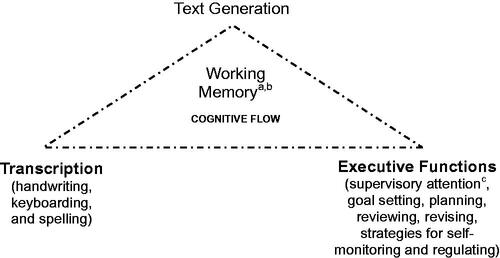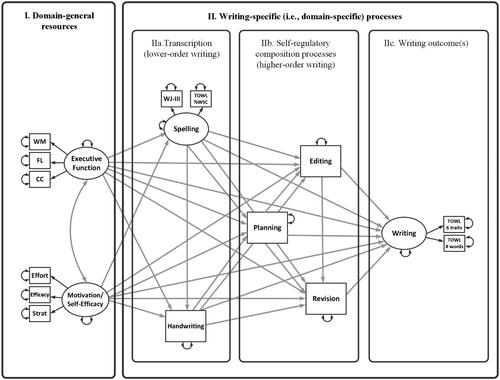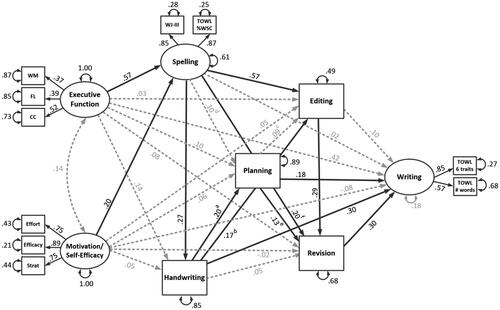Figures & data
Figure 1. Schematic of the Not-so-Simple View of Writing as a theoretical model. From Berninger and Winn (Citation2006, p. 97). Copyright © 2006 The Guilford Press. Reprinted by permission. aActivates long-term memory during planning, composing, reviewing, revising, and short-term memory during reviewing and revising output. bComponents include (1) orthographic, phonological, and morphological storage units for verbal information, (2) a phonological loop for learning words and maintaining verbal information actively in working memory, and (3) executive supports that link verbal working memory with the general executive system (a distributed network of many executive functions) and with nonverbal working memory (which stores information in a visual-spatial sketchpad). cA complex system that regulates focused attention – selecting what is relevant and inhibiting what is not relevant, switching attention between mental sets, attention maintenance (staying on task), conscious attention, (metalinguistic and metacognitive awareness), cognitive presence, and cognitive engagement.

Figure 2. Schematic of the Not-so-Simple View of Writing (NSVW) as an empirical model. Note. %WSC: % words spelled correctly; CC: cognitive control; FL: fluency; Strat: learning strategies; TOWL: Test of Written Language; WJ-III: Woodcock Johnson-III; WM: working memory.

Figure 3. Standardized results for the full model. Note. %WSC: words spelled correctly; CC: cognitive control; FL: fluency; Strat: learning strategies; TOWL: Test of Written Language; WJ-III: Woodcock Johnson-III; WM: working memory. aHandwriting to planning; bhandwriting to editing; cplanning to editing; dspelling to planning; eplanning to revision; fspelling to revision. Solid lines represent significant direct effects or correlations; dashed lines represent non-significant direct effects or correlations. Parameter estimates are shown for direct effects only.

Table 1. Descriptive statistics by grade and for the overall sample.
Table 2. Standardized solution for total, total indirect and specific indirect effects from the full model.
Table A1. Correlations among observed measures.
Table A2. Correlations among latent/observed variables from the NSVW model.
